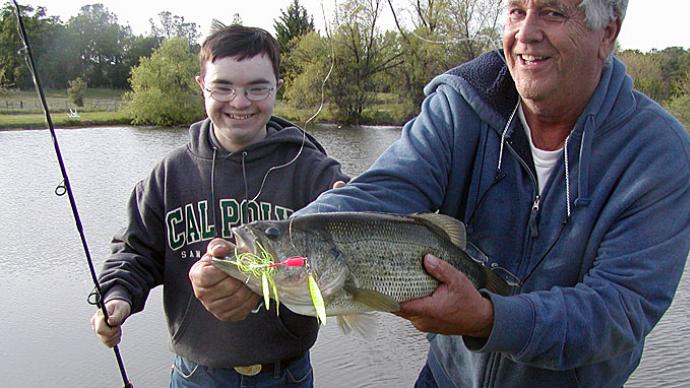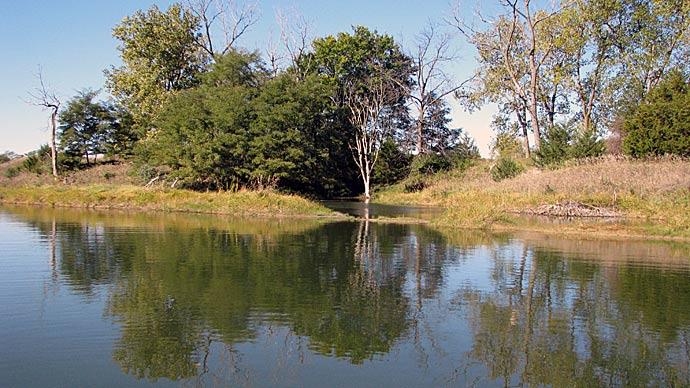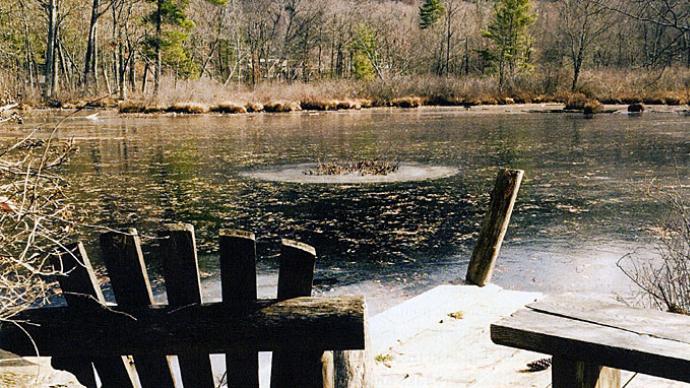
It was a perfect spring evening. You know the one, late-April (2017 to be exact), 65 degrees, no humidity, the setting sun moving in and out of the orange and blue clouds nestled on the horizon. The pond was teaming with new life. Peepers peeping, bullfrogs croaking, the occasional mosquito swirling around my head. And, of course, bass fishing. This evening didn't end with just the beauty of the surroundings. It extended to the fishing. In a small area of the 3.6-acre pond, an area about the size of a 3-car garage, six feisty bass met the "business end of my fishing pole," as Bob Lusk would say! In just 10 minutes! Also, I used three different poles with three different lures. Caught a bass with each one, and I am just a novice fisherman at best. I almost didn't have time to breathe. I definitely had no time to contemplate what just happened!
When my heart, pulse, and breathing settled down, I pondered, "Was this a chance encounter with six bucket-mouths? Was this the culmination of those magical fishing conditions: right temperature, right barometer, proper sun angle, correct lure presentation (definitely not), yada, yada, yada? Or, was this hours of planning and creating that magical fishing spot, on purpose?!" Likely it was some of all three, but mostly the latter.
In my heart, I knew the answer! Let me explain.
The pond in question was a brand-new pond that was started in June 2016 when we dammed up a cattle pasture. From the start, it was planned and built to be a quality bass fishery. Every square foot of the 3.6-acre pond was constructed with a purpose. Nothing left to chance. As the Pond Boss, Bob Lusk, says, "Fish need a place to spawn, hide, feed, congregate and loaf." Every effort was made to provide all these, and at all depths. It was built for all seasons and to give all the fish—forage fish, target species (bass), fingerlings and adults—all they need to survive and thrive. Even the stocking Bob recommended was well thought-out and implemented. (By the way, 150 12-inch bass were stocked several weeks earlier, for those wondering how I was catching bass in this new pond. But that's another story for another article).
The dream of building the pond started over 15 years ago, long before the land was even purchased. All I knew was, "Someday I'm going to build my dream bass pond." Countless hours of study went into learning about the habits of bass and their primary forage species, bluegill. Most of this time was spent reading books and magazines, primarily Pond Boss, and watching videos with Bob Lusk narrating great information. Much time was spent thinking and planning the way the bottom, banks, cover, structure, etc. would be laid out in my future pond, or at least what I would want in a pond that would be built on the land I didn't even own yet. Call me crazy, or obsessed. Your choice!
Then that day finally arrived! I purchased that dream farm that had a perfect place to build my perfect pond. I say that somewhat tongue in cheek, but to me, it is all a dream come true; and it's perfect, or as close as one can get.
As I thought about the design of the pond, the points that Bob made during his site visit, and many comments in his books and magazine articles, kept ringing in my head. He stressed that 90% of the fish live in 10% of the water at any given time; however, that 10% changes with the seasons, water temps, oxygen levels, time of day etc. Therefore, the overriding principle was to make sure we had places for bass and bluegill for all these different conditions and seasons.
Now back to that magical spot!

This magical spot was designed to be a spring/fall location in the pond. It's in a shallow section, because I learned that as a general rule, as the water starts to warm, bass start migrating from their winter depths to shallower water, because that's where the baitfish are! Also, that's where the bass stage in preparation for the spawn. Now, shallow water is a relative term. In our pond, the deepest water is about 15 feet.
What do fish need in the spring? They need a place to feed. Bass feed at all times of the year, but it ramps up in the spring. As fish recover from winter and prepare for the spawn, feeding increases. Also, fish being cold-blooded, their metabolism increases as the water temperature warms, and they feed more (more points learned from the Pond Boss). Nature provides a bounty during this time of year. Algae starts growing again, zooplankton and phytoplankton ramp up, bugs are everywhere, tadpoles are swimming, frogs are croaking—you get the picture. All make great meals for our fish, and most of these can be found in shallower water and/or around the pond banks.
The spot in question is at the beginning of a shallow cove that runs about 100 feet long and is about 40 feet wide. This cove runs, at the deepest, about 8 feet and is about 4 feet deep around the edges/banks. We strategically dug this cove so that it would lie adjacent to a deeper section of the pond.
We enhanced this cove further. In our design, we built a small underwater island along the bank at the beginning of this cove. It has depths from 6 inches to about 2 feet. It's great for weed growth. It's also great for bluegill spawning. Those weeds offer great dense cover for all the minnows, small baitfish, tadpoles, etc. That area acts as a nursery for tiny fish. Also, the base of the food chain is here, with lots of plankton, algae, bugs, etc. Small fish feed on all these morsels and big fish feed on small fish. The beginnings of our magical fishing spot.
Near the underwater island, we added artificial dense cover, in the form of Mossback Root Wads, and several concrete/rock piles. More thoughts from Bob rang in my ears when adding these. Small forage fish need dense cover to hide and feed in. If they don't have it, they are quick, easy meals for bass and large bluegill, which disrupts the food chain. If you note in the picture in Photo 1, there are Mossback Root Wads on one side of the cove (in front of me) and concrete/rocks in several spots in front and behind me. Algae and periphyton will grow on both these habitat features and add to the food chain. Also, they provide plenty of places for small fish to hide and feed.
What's next? Spawning! Bass and bluegill start spawning in the spring. More Bob Lusk wisdom. Bob told me bass spawn in isolated beds 25-30 feet apart and ideally in 3-5 feet of water. Bluegill spawn more in groups and colonies in shallower water, 1-2 feet ideally. Back to Photo 1. Behind me, on the underwater island, we created a bluegill spawning bed about 15' by 20' in 1-2 feet of water, right beside the weed beds. In front of me in the picture, you will see bass spawning beds in 4 feet of water spread about 25 feet apart. Those are for bass, if they'll use them.
Near those are the Mossback Root Wads, which are great protection for the hatching fry or small forage fish feeding in the area.
What about big bass? Where do they hang out? It's great to protect baitfish, have great feeding areas, and create spawning beds, but how do we concentrate bass so we can catch them? Lusk says bigger fish like more fluffy cover. Fluffy cover has more space for bass to move about and relate to. More Mossback! Mossback Trophy Trees have limbs that are further apart. Perfect for larger bass and bluegill to move around and still relate to the cover. We installed several Mossback Trophy Trees in the deeper part of the cove, around the 6-7-foot depth. We also placed these so they are strategically close to dense cover and the underwater island. Remember, bass like to ambush their prey and move quickly back to cover. In Photo 1, they are to my left and some are behind me.
More.
We created a steep drop-off from the underwater/spawning island, behind me in Photo 1. We enhanced this further with some concrete and rocks. Several years ago, I watched a video that Bob did about structure. What stuck with me was that bass prefer hanging/feeding in shallow water with quick access to deep water. Hence, the steep drop-off. The depth goes from two feet at the edge of the island quickly down to seven feet. We also created an underwater hump off to one side of the underwater island. Every bass fisherman knows bass relate to structure such as steep drop offs, humps, holes, points, and similar.
Oh yeah, we also positioned this magical spot right beside a point we created using excess dirt from digging out the cove. This point helps separate this cover from the deeper body of the pond. Remember, bass love to travel and congregate around points!
Another unique feature of this magical spot is its tendency to be a natural travel lane. The cove is about 100 feet long. There is more spawning and feeding habitat farther down the cover. Since this spot is at the beginning of the cove, any bass/bluegill traveling to and from the cove must pass through this area. It acts as a natural, well in this case, a manmade funnel!
Last but not least, we placed a medium-sized tree near the beginning of this cove with its trunk facing the deeper part of the pond to form a sort of travel corridor leading to and from the cove.
What about the fall season? Fall brings much of the same conditions as spring, from a water temperature perspective. Bass move back to the shallows in the cooler fall after being a deep-water dweller during summer heat. They also feed up for the cold winter months. They find more food near those shallow banks and it's easier for them to ambush their prey. So, this magical spot will fit the fall bill too!
Where did I catch the six bass in 10 minutes?
Two were caught by the drop-off. I caught another two between the tree and one of the Mossback Trophy Trees. One was caught near the underwater hump, and the last was hooked on the concrete/rock pile beside one of the Mossback Root Wads.
So, was it one of those perfect fishing days where all was right in the fishing world? Or was it a well thought out plan we diligently implemented? You decide! I choose to believe we did our research, set our plan in motion, and created this magical fishing spot! The bass did the rest.
Reprinted with permission from Pond Boss Magazine



